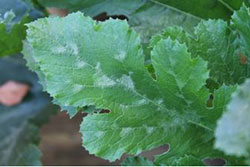
Seasons with high rain fall and high humidity give gardeners the rare (for Colorado) opportunity to observe many types of leaf diseases. Warm, wet, and humid weather creates ideal conditions for leaf disease development and spread. Overwatering or inappropriate practices can allow disease the same opportunity.
Water (or high humidity) is needed to activate bacterial, fungal and nematode pathogens before they can infect plants. For example, spore release from fungal fruiting structures is initiated by water.
Splashing or running water can spread fungal spores and bacterial ooze from plant to plant or to different locations on the same plant. Water efficiently transports pathogens and wet leaf surfaces provide ideal environments for infection. Many spores germinate and infect wet leaves quickly.
Abundant water increases the succulence of plants, making them more susceptible to pathogens. Increased susceptibility usually means an increase in disease severity. High concentrations of water in plant tissues especially favor bacteria.
The number of rain events increases some pathogen’s infection cycles depending on how long foliage remains wet. If the minimum wet period doesn’t occur, there is no disease.
Gardeners can decrease leaf infections through careful plant thinning and pruning to allow drying air to move through plants. Dense leaf canopies have poor air circulation and retain high moisture levels favoring disease development. It is also important to avoid watering sensitive plants with sprinkler systems, aim to use a drip system (which is also water wise in our dry state).



